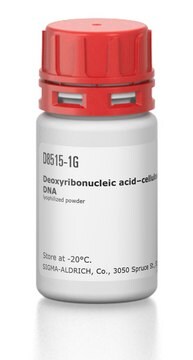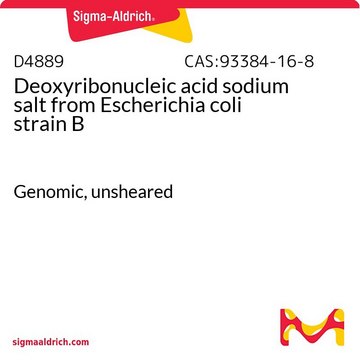D8661
Deoxyribonucleic acid solution from calf thymus
For hybridization
Iniciar sesiónpara Ver la Fijación de precios por contrato y de la organización
About This Item
Productos recomendados
biological source
bovine thymus
Quality Level
grade
for molecular biology
assay
9-11 mg/mL (DNA concentration)
form
solution
shipped in
dry ice
storage temp.
−20°C
General description
A ready-to-use solution of high quality double-stranded template DNA isolated from the thymus of male and female calves. The solution is supplied at a concentration of 9 - 12 mg/ml .
Application
Deoxyribonucleic acid solution from calf thymus is suitable for use as a blocking agent in Southern hybridizations. It was used as negative control in DNA-DNA hybridization experiments using genomic DNA preparations of Vibrio parahaemolyticus and Vibrio alginolyticus. It was used as a standard for DNA quantification by fluorescent assay.
Many factors contribute to the signal-to-noise ratio in nucleic acid hybridizations. These factors include the presence of solvent (formamide), hybridization temperature, length of hybridization, volume of hybridization solution, degree and method of agitation, use of blocking reagents, concentration and specific activity of the probe, use of molecular agents to increase the rate of nucleic acid reassociation, and the degree of stringency used during the washing of the membrane.
In order to decrease any non-specific hybridization of the probe to a substrate, blocking agents must be used. Generally, a combination of blocking reagent, detergent, and denatured, fragmented DNA is used to accomplish this. Sigma offers sonicated, denatured DNA from a variety of species for use as a blocking agent in Northern and Southern blotting and other nucleic acid hybridization techniques.
In order to decrease any non-specific hybridization of the probe to a substrate, blocking agents must be used. Generally, a combination of blocking reagent, detergent, and denatured, fragmented DNA is used to accomplish this. Sigma offers sonicated, denatured DNA from a variety of species for use as a blocking agent in Northern and Southern blotting and other nucleic acid hybridization techniques.
Many factors contribute to the signal-to-noise ratio in nucleic acid hybridizations. These factors include the presence of solvent (formamide), hybridization temperature, length of hybridization, volume of hybridization solution, degree and method of agitation, use of blocking reagents, concentration and specific activity of the probe, use of molecular agents to increase the rate of nucleic acid reassociation, and the degree of stringency used during the washing of the membrane.
In order to decrease any non-specific hybridization of the probe to a substrate, blocking agents must be used. Generally, a combination of blocking reagent, detergent, and denatured, fragmented DNA is used to accomplish this. Sigma offers sonicated, denatured DNA from a variety of species for use as a blocking agent in Northern and Southern blotting and other nucleic acid hybridization techniques.
Deoxyribonucleic acid solution from calf thymus has been used in in situ hybridization and microarray hybridization.
In order to decrease any non-specific hybridization of the probe to a substrate, blocking agents must be used. Generally, a combination of blocking reagent, detergent, and denatured, fragmented DNA is used to accomplish this. Sigma offers sonicated, denatured DNA from a variety of species for use as a blocking agent in Northern and Southern blotting and other nucleic acid hybridization techniques.
Deoxyribonucleic acid solution from calf thymus has been used in in situ hybridization and microarray hybridization.
Preparation Note
This DNA is phenol-chloroform extracted, ethanol precipitated, and sonicated to produce single-stranded fragments which comigrate with the 587 and 831 base pair marker fragments.
Other Notes
DNA in solution will reanneal on standing at room temperature so it is recommended to boil the solution for 10 minutes and then cool on ice for at least 5 minutes prior to use.
Related product
Referencia del producto
Descripción
Precios
Storage Class
12 - Non Combustible Liquids
wgk_germany
WGK 2
flash_point_f
Not applicable
flash_point_c
Not applicable
ppe
Eyeshields, Gloves, type N95 (US)
Certificados de análisis (COA)
Busque Certificados de análisis (COA) introduciendo el número de lote del producto. Los números de lote se encuentran en la etiqueta del producto después de las palabras «Lot» o «Batch»
¿Ya tiene este producto?
Encuentre la documentación para los productos que ha comprado recientemente en la Biblioteca de documentos.
Los clientes también vieron
Frequency of aneuploidy in in vitro-matured MII oocytes and corresponding first polar bodies in two dairy cattle (Bos taurus) breeds as determined by dual-color fluorescent in situ hybridization
Nicodemo D, et al.
Theriogenology, 73(4), 523-529 (2010)
Annick Robert-Pillot et al.
FEMS microbiology letters, 215(1), 1-6 (2002-10-24)
We compared the efficiencies of biochemical methods and polymerase chain reaction (PCR) for the identification of Vibrio parahaemolyticus strains. The 122 isolates studied, identified by biochemical tests as V. parahaemolyticus or Vibrio alginolyticus, were tested by R72H PCR assay. The
C Booth et al.
Nucleic acids research, 29(21), 4414-4422 (2001-11-03)
We have developed a method that allows quantitative amplification of single-stranded DNA (QAOS) in a sample that is primarily double-stranded DNA (dsDNA). Single-stranded DNA (ssDNA) is first captured by annealing a tagging primer at low temperature. Primer extension follows to
Romina Ponzielli et al.
Nucleic acids research, 36(21), e144-e144 (2008-10-23)
High-throughput, microarray-based chromatin immunoprecipitation (ChIP-chip) technology allows in vivo elucidation of transcriptional networks. However this complex is not yet readily accessible, in part because its many parameters have not been systematically evaluated and optimized. We address this gap by systematically
Clare L Abram et al.
The Journal of biological chemistry, 278(19), 16844-16851 (2003-03-05)
Fish is a scaffolding protein and Src substrate. It contains an amino-terminal Phox homology (PX) domain and five Src homology 3 (SH3) domains, as well as multiple motifs for binding both SH2 and SH3 domain-containing proteins. We have determined that
Nuestro equipo de científicos tiene experiencia en todas las áreas de investigación: Ciencias de la vida, Ciencia de los materiales, Síntesis química, Cromatografía, Analítica y muchas otras.
Póngase en contacto con el Servicio técnico











